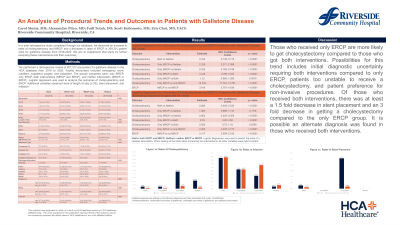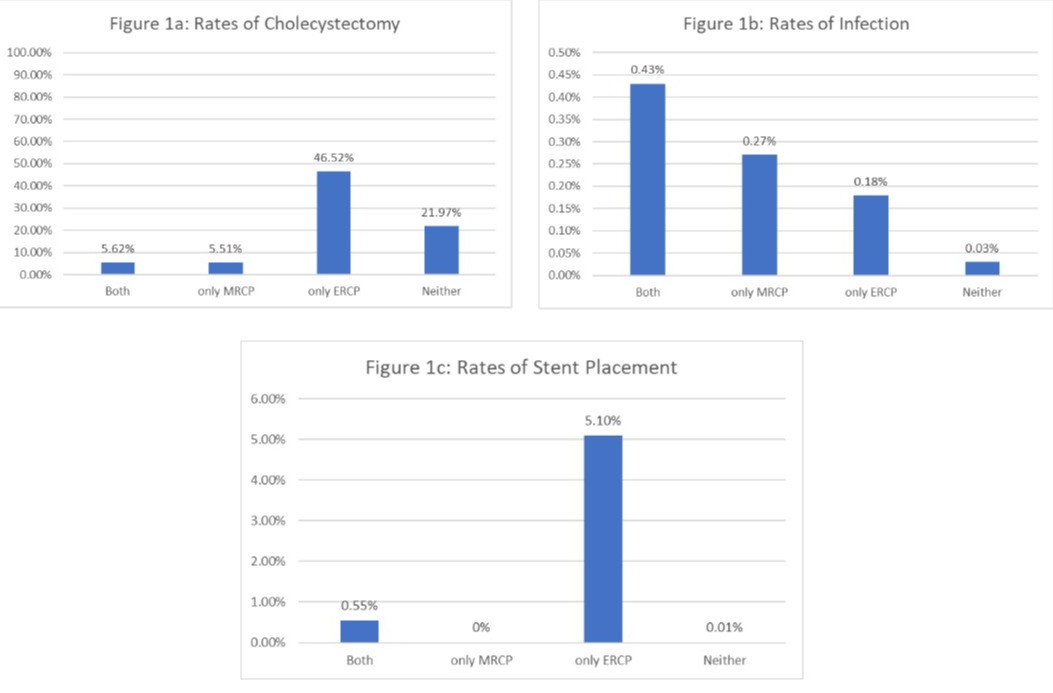Tuesday Poster Session
Category: Biliary/Pancreas
P2890 - An Analysis of Procedural Trends and Outcomes in Patients With Gallstone Disease
Tuesday, October 24, 2023
10:30 AM - 4:00 PM PT
Location: Exhibit Hall

Has Audio

Carol Monis, MD
Riverside Community Hospital
Riverside, CA
Presenting Author(s)
Carol Monis, MD1, Alessandra Pitco, MD1, Fadi Totah, DO1, Scott Kubomoto, MD1, Eric Choi, MD, FACG2
1Riverside Community Hospital, Riverside, CA; 2Riverside Community Hospital; Altais Medical Group, Riverside, CA
Introduction: Gallstone disease is often investigated by various imaging modalities and procedures. In a prior retrospective study completed through our database, we observed an increase in rates of cholecystectomy and MRCP and a decrease in rates of ERCP in patients with gallstone disease. We aim to supplement that study by further analyzing these interventions and their outcomes.
Methods: We performed a retrospective review of 207,317 encounters for gallstone disease in the HCA database from 2016 to 2020. Facility encounters included emergency room, inpatient, and outpatient. The groups compared were: only MRCP, only ERCP, both interventions (MRCP and ERCP), and neither intervention (MRCP or ERCP). Logistic regression was used to analyze the outcomes of cholecystectomy and ERCP. Additional variables observed were of length of stay (LOS), stent placement, and infection.
Results: 12,645 patients received only MRCP, 31,953 received only ERCP, 8778 received both interventions, and 193,456 received neither intervention. Patients that received MRCP were 3.916 times as likely to receive an ERCP compared to those that did not receive MRCP (p= < 0.0001). Patients that received only ERCP were 12.729 times as likely to receive a cholecystectomy compared to those that received only MRCP (p= < 0.0001). Patients that received only ERCP are 14.29 times as likely to receive a cholecystectomy compared to those that received both interventions (p= < 0.0001). Patients that received only MRCP are 1.12 times as likely to receive a cholecystectomy compared to patients who received both interventions (p= 0.0576). Median LOS was 4 days for both interventions, 3 days for only MRCP, 1 day for only ERCP, and 0 days for neither intervention. Rates of cholecystectomy, infection, and stent placement are seen in Figure 1.
Discussion: Evaluation for gallstones frequently involves imaging prior to intervention. There are more visits for only MRCP compared to both interventions, and those who received only MRCP are more likely to get cholecystectomy compared to those who got both interventions. Possibilities for these trends include ruling out obstructing stone after MRCP, patients too unstable to receive a cholecystectomy, and patient preference for non-invasive procedures. Of those who received both interventions, there was a 9 fold decrease in stent placement and an 8 fold decrease in getting a cholecystectomy compared to the only ERCP group. It is possible an alternate diagnosis was found in those who received both interventions.

Disclosures:
Carol Monis, MD1, Alessandra Pitco, MD1, Fadi Totah, DO1, Scott Kubomoto, MD1, Eric Choi, MD, FACG2. P2890 - An Analysis of Procedural Trends and Outcomes in Patients With Gallstone Disease, ACG 2023 Annual Scientific Meeting Abstracts. Vancouver, BC, Canada: American College of Gastroenterology.
1Riverside Community Hospital, Riverside, CA; 2Riverside Community Hospital; Altais Medical Group, Riverside, CA
Introduction: Gallstone disease is often investigated by various imaging modalities and procedures. In a prior retrospective study completed through our database, we observed an increase in rates of cholecystectomy and MRCP and a decrease in rates of ERCP in patients with gallstone disease. We aim to supplement that study by further analyzing these interventions and their outcomes.
Methods: We performed a retrospective review of 207,317 encounters for gallstone disease in the HCA database from 2016 to 2020. Facility encounters included emergency room, inpatient, and outpatient. The groups compared were: only MRCP, only ERCP, both interventions (MRCP and ERCP), and neither intervention (MRCP or ERCP). Logistic regression was used to analyze the outcomes of cholecystectomy and ERCP. Additional variables observed were of length of stay (LOS), stent placement, and infection.
Results: 12,645 patients received only MRCP, 31,953 received only ERCP, 8778 received both interventions, and 193,456 received neither intervention. Patients that received MRCP were 3.916 times as likely to receive an ERCP compared to those that did not receive MRCP (p= < 0.0001). Patients that received only ERCP were 12.729 times as likely to receive a cholecystectomy compared to those that received only MRCP (p= < 0.0001). Patients that received only ERCP are 14.29 times as likely to receive a cholecystectomy compared to those that received both interventions (p= < 0.0001). Patients that received only MRCP are 1.12 times as likely to receive a cholecystectomy compared to patients who received both interventions (p= 0.0576). Median LOS was 4 days for both interventions, 3 days for only MRCP, 1 day for only ERCP, and 0 days for neither intervention. Rates of cholecystectomy, infection, and stent placement are seen in Figure 1.
Discussion: Evaluation for gallstones frequently involves imaging prior to intervention. There are more visits for only MRCP compared to both interventions, and those who received only MRCP are more likely to get cholecystectomy compared to those who got both interventions. Possibilities for these trends include ruling out obstructing stone after MRCP, patients too unstable to receive a cholecystectomy, and patient preference for non-invasive procedures. Of those who received both interventions, there was a 9 fold decrease in stent placement and an 8 fold decrease in getting a cholecystectomy compared to the only ERCP group. It is possible an alternate diagnosis was found in those who received both interventions.

Figure: Rates of Various Outcomes in Patients with Gallstone Disease
Disclosures:
Carol Monis indicated no relevant financial relationships.
Alessandra Pitco indicated no relevant financial relationships.
Fadi Totah indicated no relevant financial relationships.
Scott Kubomoto indicated no relevant financial relationships.
Eric Choi indicated no relevant financial relationships.
Carol Monis, MD1, Alessandra Pitco, MD1, Fadi Totah, DO1, Scott Kubomoto, MD1, Eric Choi, MD, FACG2. P2890 - An Analysis of Procedural Trends and Outcomes in Patients With Gallstone Disease, ACG 2023 Annual Scientific Meeting Abstracts. Vancouver, BC, Canada: American College of Gastroenterology.

